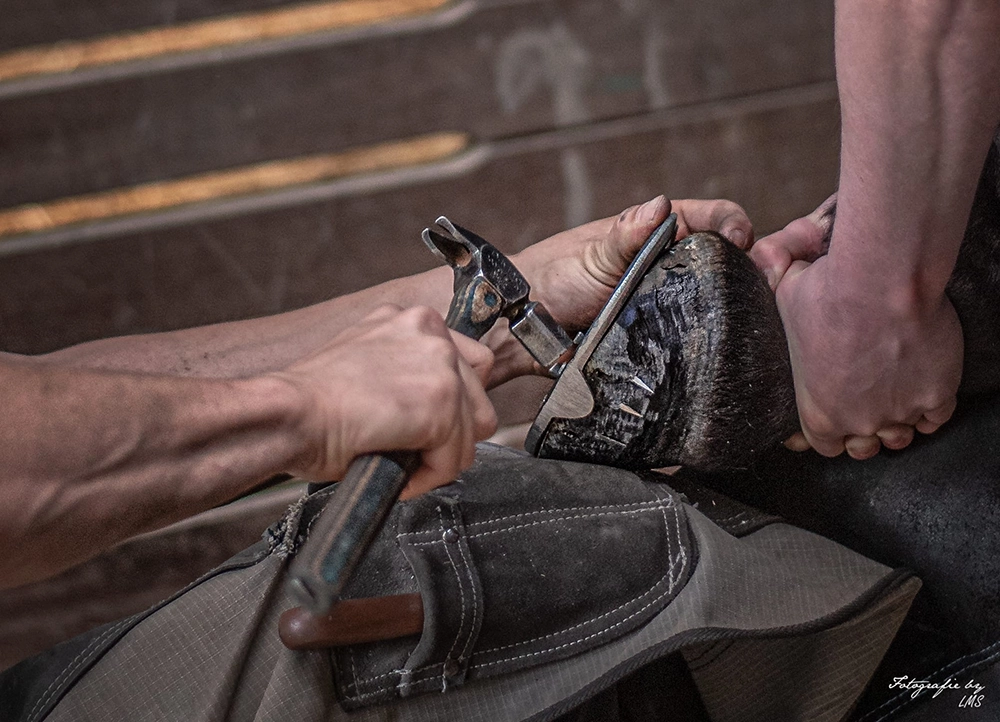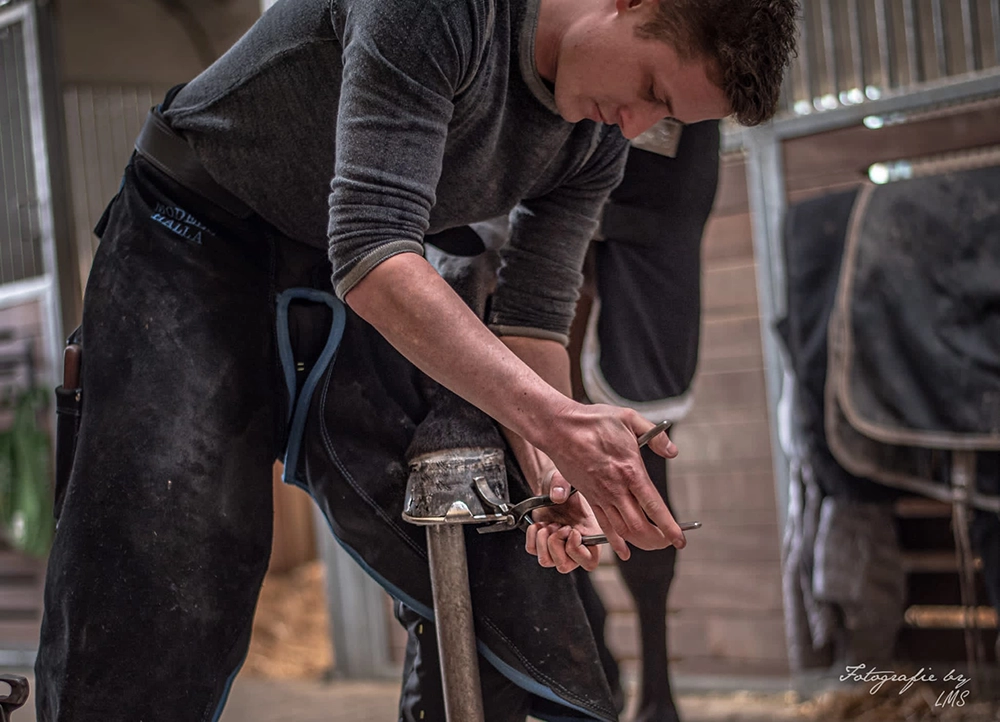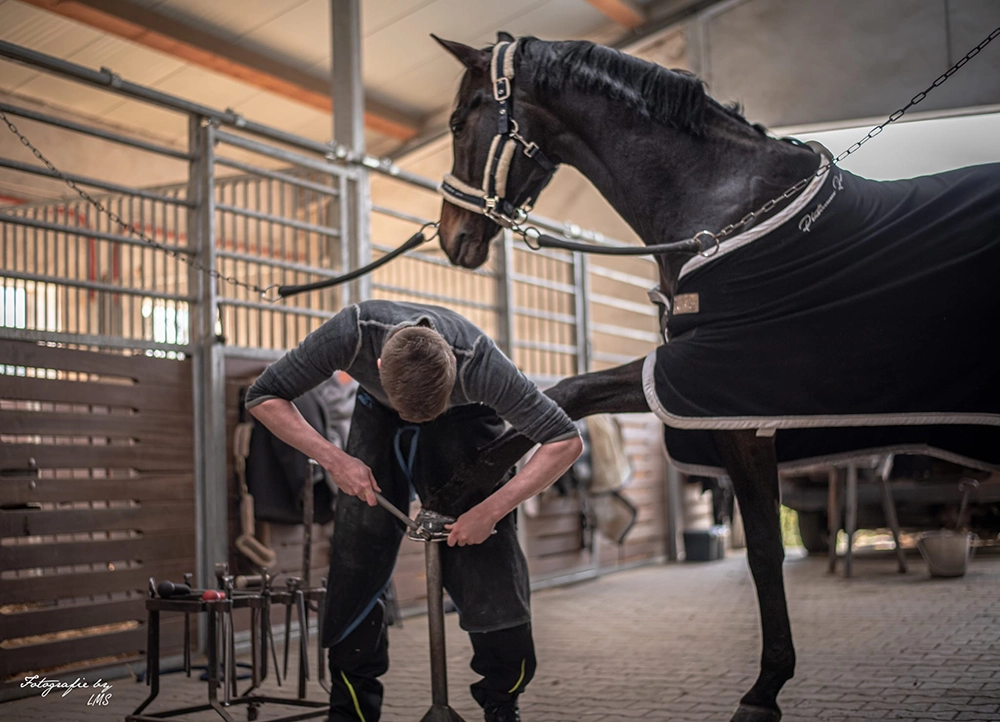
Hoof Care: From the History of the Farrier to the Most Common Hoof Diseases
Learn All About Your Horse’s Hooves
The History of the Farrier
The Farrier in the Middle Ages and Today
The profession of the farrier has existed for about 5,000 years. Along with the weaponsmith, he is one of the oldest representatives of the blacksmithing trade. Until the 20th century, they were also referred to as coarse smiths, because in earlier times, in addition to shoeing horses, they also made agricultural tools, equipment, and rough iron goods.
At that time, the smith was essentially a “man for everything”: he shod wagon wheels, crafted jewelry, pulled people’s teeth, and fitted horses with horseshoes. Even then, the apprenticeship for this profession lasted two to three years. Back then, people had to bring their horses to the smithy; nowadays, however, the farrier is mobile and comes directly to the horses in their stables.
Today, his work is limited exclusively to everything related to the horse’s hoof. The farrier is a specialist in hoof care, corrects barefoot horses, and takes care of shoeing. Most farriers still make their horseshoes and nails themselves or adapt them to the shape of the hoof. They also produce hoof boots, which can either be permanently glued to the hoof or, like a regular shoe, be put on for each ride. The farrier also detects and treats hoof inflammations and can, with the help of special shoes, support the healing process of the hooves.

The Development of the Horseshoe
In the 1st century BC, an “iron sole” was mentioned for the first time as equipment for horses. The oldest historically documented hoof coverings include the woven sandal, which first appeared around 500 BC. Equipped with an iron sole, it was fastened with straps around the horse’s fetlock area. Around 50 BC, the hipposandal was developed, an iron shoe attached with leather straps.
About 1,500 to 2,000 years ago, nailed-on iron shoes were introduced in Central Asia as hoof protection. In the 9th and 10th centuries, horseshoeing also spread to Europe, which made horses more efficient for work. For many centuries, every horseshoe was handmade, but since the late 19th century, factory-made horseshoes have also been available. In 1934, the “Army Horseshoe 32” was introduced by the German Wehrmacht. Even today, its dimensions still serve as the basis for some horseshoe designs.
The Evolution of the Hoof
Due to climate change that altered soil conditions, former multi-toed animals evolved into single-toed animals (hooves). The development of the horse’s hoof into a single toe also brought with it an increase in body size, as horses were once as small as a fox and lived in the forest. A remnant from this time is the chestnut on the inside of the horse’s leg.
The Work of a Farrier
What tools does a farrier use?
Even today, the farrier works with traditional tools such as fire, the anvil, a hoof stand, cooling tub, pull-offs, shoeing hammer, pritchel, hoof knife, horseshoe nails, rasp, farrier’s pincers, drawing knife, wooden mallet, screw studs, and crampons.
In the past, horseshoes were traditionally forged from iron; today, durable steel, aluminum, or even plastic is often used. For forging, the flat iron is heated until glowing in the fire, called the forge, and then shaped and worked with a hammer on the anvil.

The 4 Types of Horseshoes
Not all horseshoes are the same – there are different types that vary in material, shape, and weight. Today, horseshoes can be made of aluminum, plastic, or iron. But which is actually better – plastic horseshoes or iron ones?
It essentially depends on the individual horse. If it is a gaited horse, show jumper, or racehorse, the shoeing must, of course, be adapted to the discipline. The age of the horse also plays an important role. Therefore, standard shoes, special shoes, and orthopedic horseshoes are all part of a farrier’s everyday work. But how do these types of horseshoes differ?
The Racing Shoe:
The so-called racing shoe, like the classic horseshoe, is made of iron and is used for racehorses.
To reduce weight, it is often made of light metals such as aluminum.
The Aluminum Horseshoe:
Made of aluminum, this type is especially suitable for gaited horses and racehorses.
It can also be used for young horses. However, it should be noted that aluminum horseshoes are only suitable for cold shoeing.
The NBS Shoe:
NBS stands for “Natural Balance Shoe” and is also made of iron.
It is increasingly used for jumping horses because it promotes better breakover
and is suitable for all breeds.
Easy-Walker Shoe:
This horseshoe is made of plastic and is nailed on like a regular shoe.
It has shock-absorbing properties and is particularly lightweight.
The most important thing with the different types of horseshoes is that hoof protection must not have any negative effects on the horse’s health. Horseshoes should also assist in correcting limb deviations and treating diseases. As an alternative to horseshoes, hoof boots can be used. These are usually fitted and glued by the farrier or, like a regular shoe, put on before each ride.
Shoeing the Hooves
For the farrier to re-shoe your horse, the old horseshoe must first be removed and the hooves prepared for the new shoeing. The farrier begins by cleaning the sole, examining the hoof for injuries or diseases, and then trimming back the horn. At first, the softer horn is trimmed with a drawing knife, followed by the removal of harder horn parts using the pritchel and hoof hammer.
The hoof is then smoothed with a rasp, and the horseshoe is fitted. For this purpose, the shoe is reheated and, if necessary, slightly adjusted. It is then pressed hot onto the hoof and nailed into place by the farrier using horseshoe nails. These nails have a rectangular head and are driven in with the shoeing hammer. Finally, the nails are clinched to the outer hoof wall with a clinching blade.
Training to Become a Farrier
The correct German job title is “Hufbeschlagschmied” (certified farrier) and refers to a specialist in shoeing animal hooves with horseshoes or other materials. “Hufbeschlagschmied” is not an independent vocational training profession but an advanced qualification, for which a completed apprenticeship in a skilled trade is required.
After the four-week introductory course, one must work for at least two years full-time with a state-recognized farrier for practical training. The introductory course must be completed before starting practical work and is divided into a theoretical and practical part totaling 160 hours. A four-month preparatory course is then followed by the official farrier exam. During training, the farrier does not receive a salary and must cover the costs of farrier schools independently.
Exam contents:
- Carrying out hot shoeing with iron
- Carrying out shoeing with alternative materials
- Performing barefoot trimming
- Forging a horseshoe
- Preparing a case study with technical discussion
- Written exam, possibly with an additional oral examination
The Most Common Hoof Diseases
Defining which are the most common hoof diseases in horses is not so simple, as these can vary over time and there are quite a few of them. They range from conditions caused by poor or insufficient care to genetically predisposed hoof diseases.
Currently, there are increasing problems with White Line Disease, which can lead to a hollow or detached hoof wall, an abscess, and a foul-smelling change in the hoof horn. This disease was less common in the past and usually develops as a result of poor hoof care. The culprits are bacteria or fungi.
Laminitis is familiar to almost every horse owner and describes a painful inflammation of the laminae. It is categorized into hormone-related, toxin-related, and mechanically induced laminitis. This disease occurs less frequently today than in the past – likely due to better education and greater awareness of how to prevent this inflammation.
Navicular Disease is also no longer uncommon. As the name suggests, this is a painful inflammation of the navicular apparatus. It often arises from overstrain, particularly in jumping horses. However, irregular hoof shapes, improper shoeing, poor hoof care, or underrun heels can also lead to navicular disease.
Suspensory ligament injuries and coffin joint diseases are also frequent issues, especially in sport horses. A suspensory ligament injury refers to overstrain that causes a sprain, which in turn triggers inflammation. In most cases, this diagnosis means at least half a year of rest.

How Often Should Your Horse See the Farrier?
Is your horse shod?
Depending on how the hoof horn grows, a horse needs new shoes every 6–10 weeks.
Is your horse barefoot?
Here too, depending on horn growth, the hooves should be trimmed every 4 to a maximum of 12 weeks –
provided there are no major conformational issues or hoof problems.
How Do We Support Your Hoof Care?
Our hoof oil is a concentrated blend of more than ten ingredients that restores and supports healthy, flexible hooves while forming a breathable moisture film that helps maintain the optimal moisture balance.
With its antibacterial and antifungal properties, it helps keep hooves healthy and free from infections while promoting horn growth. It provides year-round protection and is suitable for both wet and dry conditions. In addition, it is highly absorbable, drip-free, suitable for all hoof colors, and leaves a long-lasting shine.
SPECIAL FEATURE: The unique and natural composition of our hoof care changes consistency depending on the season. In summer, it resembles an oil or balm, while in winter it becomes slightly firmer. This prevents, for example, bacteria from muddy ground from penetrating the hoof in winter. In summer, the hoof oil forms a protective film that ensures the hooves do not become too moist.

Our Show Jumper Campino
What makes him special, and how is he shod?
Campino is a young Westphalian and, of course, a valued member of our SUNRIDE family. Together with his teammate Johan, he passionately and successfully competes in show jumping up to class S. Like every horse, he has a few particularities – including when it comes to his hooves.
In front, he is flat and long in the pasterns, and therefore has flat hooves with relatively long toes. This naturally makes it harder for him to break over from the shoulder. That’s why our farrier Max needs to be especially attentive when trimming and shoeing. In this case, the toe is shortened slightly, and the shoe is set back accordingly. This helps Campino break over more easily from the shoulder, gives him greater comfort under saddle, and allows Johan and Campino to perform at their best.